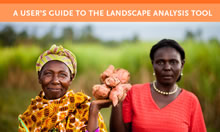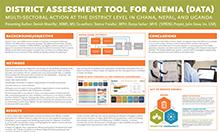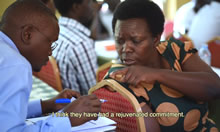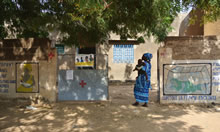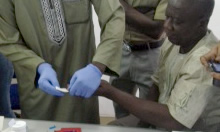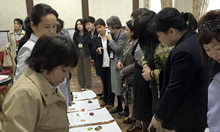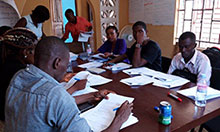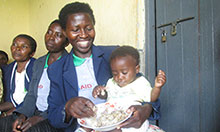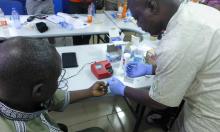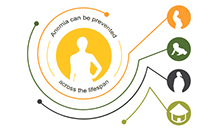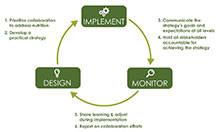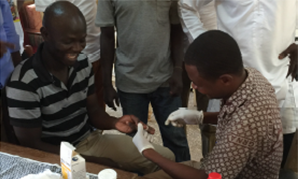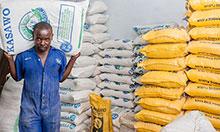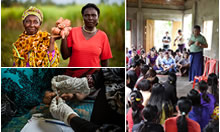From Learning to Practice
Background
Anemia is a widespread public health problem (table 1) that few countries have been able to reduce in compliance with World Health Assembly goals (figure 1). Anemia is characterized by a low concentration of hemoglobin in the blood and results in poor health and decreased economic development. For expectant mothers, serious maternal anemia increases the risk of mortality and morbidity. For children, it can mean low birth weight, prematurity, and impaired physical and cognitive development. However, there is hope—anemia prevention and control saves lives and improves long-term quality of life (Rahman et al. 2016; Lozoff et al. 2007; Global Burden of Disease Pediatrics Collaboration 2013). This brief describes country-led efforts to coordinate and implement anemia prevention and control, offering lessons learned to help other countries design the best possible solutions.
Table 1: More Than Half of All Children in Africa and Asia Are Anemic1
| Children under five | Pregnant women 15–49 years | Non-pregnant women 15–49 years | |
| Global | 43% | 38% | 29% |
| South Asia | 58% | 52% | 47% |
| Central and West Africa | 71% | 56% | 48% |
| East Africa | 55% | 36% | 28% |
Figure 1: Countries on Track to Reduce Anemia
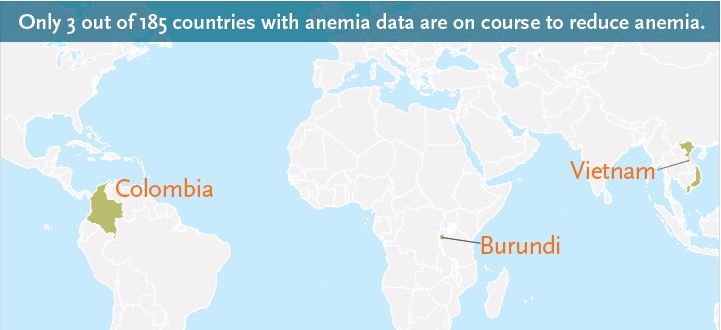
SPRING's Approach to Multi-Sectoral Anemia Programming
USAID’s Multi-Sectoral Nutrition Strategy 2014–2025 prioritizes the prevention and control of anemia (USAID 2014), which is also a major objective of SPRING.
SPRING takes a multi-sectoral and data-driven approach to address anemia. We have worked closely with the governments of Ghana, Kyrgyz Republic, Nepal, Sierra Leone, and Uganda, which have allowed us to identify common lessons learned and develop guidance tools.
In this brief, we present six key actions to address anemia:
- Generate evidence and act on it
- Engage stakeholders and build commitment
- Establish a structure for coordination and collaboration
- Develop a working strategy
- Plan and implement at subnational levels
- Train service providers
Box 1: Process Documentation as an Approach to Generate Learning
SPRING conducted a process documentation to learn from multi-sectoral anemia efforts in Sierra Leone and Uganda over a three-year period. The aim was to understand the country-led process to build commitment, set an agenda, develop a strategy, and undertake implementation. The process documentation used data from qualitative interviews with key stakeholders and National Anemia Working Group meeting documents. The results were shared in the two countries to discuss ways to improve the process and were used to develop lessons learned and recommendations for other countries. For more information, see the following links:
In the following pages, a description of each action is accompanied by country experiences, lessons learned, and available guidance tools. The actions are presented sequentially according to the process most commonly followed, but actions need not occur in this order and often intersect. For example, the process of generating evidence and acting on it may include engaging new stakeholders and build commitment. Monitoring, evaluation, research, and learning should be undertaken for each action (box 1). The six actions are based on SPRING’s experiences and are not inclusive of all that can be done to address anemia in a country.
Key Action 1: Generate Evidence and Act On It
The causes of anemia comprise a wide range of risk factors acting through interwoven mechanisms that differ by context (Balarajan 2013; SPRING 2015) (figure 2). It is critical that policymakers and programmers understand the anemia situation in their specific context, and act to address anemia based on the information and evidence they analyze. Understanding the situation can be achieved by conducting a landscape analysis. A landscape analysis also referred to as a context assessment or situational analysis, is an approach used to inform programming. Traditionally, landscape analysis methodologies use survey data, but conducting key informant interviews is useful to provide important information about institutional capacity, barriers, and facilitators of programming.
Conducting a landscape analysis presents a challenge because many factors contribute to anemia, requiring a variety of interventions that rely on expertise across different programmatic areas. SPRING has developed a Landscape Analysis Guidance document and the accompanying tool to support countries to better understand their anemia situation, as described in box 2. A country experience with conducting a landscape analysis, and the implications of the findings, are described in box 3.
Figure 2: Anemia Casual Pathways
[block:block=110]
With the (micronutrient) survey coming out, we now see the real picture and this calls for serious action… It’s not just the Ministry of Health, it’s multi-sectoral…We need all the relevant sectors to come on board for this to be a success.
-Sierra Leone NAWG member
Box 2: Guidance for Conducting a Landscape Analysis for Anemia
SPRING’s Landscape Analysis Guidance supports policymakers and implementers to gather and interpret anemia-related data. An accompanying Excel-based tool allows users to aggregate and present data. To develop the guide we drew on assessment experiences from Ghana, Sierra Leone, and Uganda, and obtained validation from 34 experts.
The Guidance Outlines a Four-Step Process
| STEP | CONTENT |
|---|---|
| 1. Characterize anemia prevalence | Describes how to measure anemia and present and interpret anemia prevalence data. |
| 2. Establish causes of anemia | Maps out the anemia causal pathway (see figure 2), and outlines how to measure the risk factors, common data sources, and methodological issues. |
| 3. Review anemia policies | Outlines methods to identify and analyze policies and strategies. |
| 4. Assess status of anemia interventions | Explains how interventions contribute to anemia reduction, and how to measure program indicators, including methodological issues. |
The guidance is available on an online, interactive platform, with an option for a downloadable and printable document for offline use.
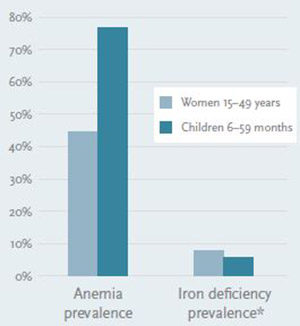
Box 3: Sierra Leone Changes Its Approach after Unexpected Findings from Its Landscape Analysis
The Government of Sierra Leone conducted an anemia landscape analysis to inform programming. The country had an advantage many others do not—data from a national micronutrient survey. Surprisingly, findings indicated that iron deficiency was not a major driver of anemia. Instead, infections and general inflammation appeared to be the key causes. The landscape analysis also revealed vast differences in the coverage of anemia-related interventions, such as high deworming and vitamin A supplementation coverage, but poor access to latrines, contraceptives, and prompt antimalarial treatment. Altogether, findings made clear that Sierra Leone would need to shift its strategy from a focus on reducing iron deficiency toward a multi-sectoral approach.
From Learning to Practice
- Conduct a landscape analysis to understand the problem, raise awareness, build partnerships, and inform strategy development.
- Consider the data and program context of all sectors involved. Non-health sector information is important and has often not been included in a landscape analysis.
- Act with the information and evidence you have, even if faced with large gaps in available data. At the same time, advocate for the collection of better data (e.g., micronutrient surveys) and the integration of anemia-related data in national surveys (e.g., agriculture and education surveys) to improve future planning.
- Ensure the landscape analysis process is driven by government stakeholders, with technical support from external experts as required.
Key Action 2: Engage Stakeholders and Build Commitment
Anemia interventions span multiple sectors (table 2) and involve many stakeholders (table 3). Traditionally, anemia programming has been led primarily by the health sector, but all stakeholders and sectors need to understand the stakes: why they should commit their resources to anemia reduction, and what results they can expect if they contribute. Emphasizing the consequences of anemia, in terms of its health, social, and economic impacts, can be effective in building commitment.
Holding national stakeholder meetings and identifying “anemia champion(s)” play an important role in building cross-sector commitment and endorsement from high-level government officials. External actors (e.g., donor priorities and implementing partners) may provide the impetus for government buy-in, but ensuring sustained efforts requires country ownership.
Table 2: Programmatic Areas and Relevant Interventions
| Agriculture and food processing | Increased production and consumption of nutrient-rich foods; biofortification; food fortification; promotion of food safety |
|---|---|
| Disease control | Prevention, control, and management of malaria; deworming for schistosomiasis and soil-transmitted helminths |
| Education | Health and hygiene education in schools; deworming for school-age children |
| Genetics | Counseling and management of genetic blood disorders related to anemia |
| Nutrition | Dietary diversification; micronutrient supplementation; maternal, adolescent, infant, and young child nutrition |
| Reproductive health | Appropriate care during pregnancy, delivery, and postnatal period; delayed cord clamping; birth spacing; reducing adolescent pregnancy |
| Water, sanitation, and hygiene | Use of appropriate and safe sanitation facilities; use of safely managed drinking water sources; water treatment; handwashing |
We are all important in the fight against anemia, and we need one another— we need a concerted effort across sectors to win the fight.
-Sierra Leone NAWG member
Table 3: Stakeholders and Their Role
| Central government | Spearhead multi-sectoral efforts to address anemia including fostering an enabling policy environment, planning and coordinating efforts, allocating funds, carrying out anemia-related mandates in the respective sectoral line ministries; and liaise with local government counterparts. |
|---|---|
| Local government | Translate central government strategies into local government structures and implementation systems; coordinate anemia-related activities through existing coordination bodies; and carry out anemia-related activities in the respective local government sectors. |
| Nongovernmental organizations and other civil society organizations including media | Provide technical assistance; mobilize communities and implement anemia prevention and control programs in conjunction with government efforts; participate in program learning on anemia interventions; lobby for government and other partner resources for anemia. |
| UN, multilateral, and bilateral development agencies | Provide technical and financial support to implement anemia-related activities; advocate for anemia prevention and control programs. |
| Donor agencies | Establish strategic vision and prioritize anemia reduction targets; provide funding for anemia-related programs through implementing partners. |
| Academic and research institutions | Conduct and ensure quality of anemia-related research; disseminate research information to inform policy and decision-making; integrate anemia prevention and control into education and training. |
| Private sector | Produce micronutrient-rich and fortified foods; engage in public-private partnerships for food fortification; foster good hygiene and child care environments |
From Learning to Practice
- Build the case for addressing anemia around consequences and gains. If unaddressed, anemia will cause significant illness, loss in productivity and, in extreme cases, risk of death, particularly among women and children. If addressed effectively, the country will achieve gains in health, social, and economic development.
- Highlight the role each sector could play in combating the problem, including the provision of succinct and accessible advocacy documents targeted to different stakeholders.
- Create innovative private and public partnerships for anemia-related interventions that can address capacity building, marketing and demand creation, and accessibility and reach.
- Identify a person or entity as an “anemia champion” to bring attention to the cause and engage the interest of stakeholders and the public.
Key Action 3: Establish a Structure for Coordination and Collaboration
Addressing anemia requires stakeholders to collaborate and align priorities. One way to achieve this is to establish a national multi-sectoral coordination platform (box 4). The platform is usually housed in a government coordinating body (e.g., Office of the Prime Minister or Vice President), or a sector ministry (e.g., Ministry of Health); the first is a natural fit for multi-sectoral engagement and the latter may allow greater involvement of technical and implementation staff. In either case, the anemia platform is often linked with the Scaling Up Nutrition (SUN) movement. Countries with coordination bodies have found that knowledge sharing, collaboration, and working relationships between government ministries and partners improve over time. However, it still remains a challenge to integrate program implementation across sectors, since planning and budgeting are often done separately, and different structures/systems for implementation are used at the district and community levels.
From Learning to Practice
- Determine where the anemia platform will be housed and formalize the arrangement through endorsement by high-level officials. Designate core leadership (e.g., Chair and Secretariat) to guide strategic vision. Often the core leadership is from the nutrition section of the Ministry of Health, but since anemia is caused by both nutritional and non-nutritional factors, this is not necessary, especially in countries where the non-nutritional factors are the main drivers of anemia.
- Identify participants, ensuring the inclusion of technical, finance, development, and planning staff across sectors. Develop terms of reference, defining roles and responsibilities.
- Dedicate staff to manage meetings, compile ideas, and track progress. Assign members the responsibility of reporting back to leadership at their respective ministries, organizations, and agencies.
- Consider the content of activities, which may include presenting emerging technical evidence; reviewing existing government anemia- related policy documents; and establishing new anemia-related policies, strategies, or guidelines.
- Develop a sustainable plan for long-term institutionalization of the coordination body; when this has not been done, efforts have eventually ceased.
Coordination across programs and stakeholders is key—sometimes we find that four or five organizations are carrying out the same work in the same place.
-Sierra Leone NAWG member
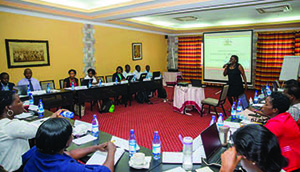
Box 4: Multi-sectoral Coordination Bodies Guide Anemia Programming in Sierra Leone and Uganda
SPRING has supported the establishment and provided technical support to national anemia working groups.
SIERRA LEONE: The Ministry of Health and Sanitation established the Sierra Leone National Anemia Working Group (NAWG) as a subgroup of the SUN Technical Working Group, chaired by the Director of Food and Nutrition Directorate, with Helen Keller International as Secretariat.
UGANDA: The Ministry of Health established the NAWG, an entity proposed but not realized in the National Anaemia Policy 2002. The platform is chaired by the Commissioner of the Community Health Department, with the Nutrition Division serving as the Secretariat.
Setting up these bodies yielded common lessons:
- Communication and follow-up were required to mitigate the conflicting commitments and competing priorities of stakeholders and sustain their participation in the working group.
- Providing all members with a foundation of anemia knowledge was needed, and was achieved through technical presentations.
- Networking opportunities, stronger working relationships, and in some instances, increased collaboration (e.g., bringing together trade; agriculture; and information, communication and technology to promote fortified and biofortified foods).
- Feedback loops between national and district efforts were viewed as important but challenging to maintain.
Key Action 4: Develop a Working Strategy
Developing a working strategy is a complex, dynamic, and time-intensive process, but results in a country-owned document approved by high-level officials and accepted by all stakeholders. Countries need to decide whether to develop a policy, strategy, and/ or guideline(s), and it may take time to reach agreement on the type of document that will be most relevant. An anemia policy document generally covers the vision and broad direction of the effort and expresses a formalized intent to address the problem. An anemia strategy generally identifies objectives and often includes an operational plan and budget to meet these objectives. A strategy has an accompanying implementation plan, which describes how activities will be implemented, monitored, and evaluated. The monitoring and evaluation framework ensures that the strategic direction and priority actions of the strategy are regularly assessed and used for decision-making, accountability, quality assurance, and learning. Costing is important to develop a realistic strategy, prioritize and target interventions, and allocate budget in the respective sectors; without addressing the higher budget implications, countries will not be able to program effectively. A guideline usually adapts globally recommended practices to a country context, which is then defined by a protocol. Often guidelines are developed for individual interventions. The decision on the type of document depends on the political situation, legal framework, and existing documents in the country.
Countries have commonly focused on iron interventions, assuming that iron deficiency is the main driver of anemia. However, anemia programming cannot use a “one-size-fits-all” approach. Many countries are now broadening their scope to address other causes of anemia and reach all vulnerable groups across the life cycle. Country examples for developing anemia strategies and guidelines are provided in boxes 5 and 6.
We sat down, and said, this [issue] is too much of a problem. If we don’t address it, we’ll never prevent anemia, so it’s a must-do. Then we looked through and made sure that this same thing is not budgeted somewhere else and funded.
-Uganda NAWG member
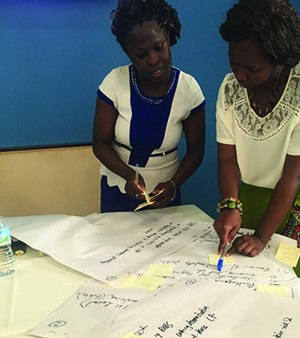
Box 5: Sierra Leone and Uganda Have Developed Multisectoral Strategies to Address Anemia
SPRING has supported development of multi-sectoral Anemia Strategies
SIERRA LEONE developed the National Strategy for Prevention and Control of Anaemia 2017-2025, the first anemia strategy in the country. They decided to identify priority actions centered on scaling up or improving interventions without being duplicative of other strategies. The strategy emerged through a process of working group meetings, one-on-one interviews, and review meetings, which enabled a strong consensus among participants.
UGANDA established the National Anaemia Prevention and Control Strategy 2016/17- 2021/22, building on its preexisting Anaemia Policy 2002. They decided to develop a comprehensive plan that does not make major changes to sector mandates but fosters an integrated, multi-sectoral approach to strengthen implementation. The new strategy resulted from a collaborative process achieved through periodic working group meetings, consultative workshops, and visits by NAWG members to districts to inform the strategy.
From Learning to Practice
- Determine how policies, strategies, and guidelines would be appropriate, and consider the time and resources needed for development. It should be a government-owned process, with external actors providing technical and/or operational support roles, if requested.
- Prioritize interventions and activities that address the main causes of anemia, considering the severity of the problem, the geographic areas and vulnerable populations to target, and the cost relative to available resources.
- Set realistic targets based on the causes of anemia, barriers and enablers, and cost-effectiveness of interventions in addressing these causes. The World Health Assembly’s global tracking tool (http://www.who.int/nutrition/trackingtool/en/) is a valuable starting point, but countries need to create their own targets.
- Frequently, a decision is made to introduce, modify, or scale-up an intervention without adequately considering the capacity needed. Tailor the strategy to the level of capacity in the country.
- Cost the interventions and activities prioritized in the anemia strategy, and ensure that sectors and stakeholders integrate additional costs into their budgets.
- Develop a monitoring and evaluation plan for the strategy to track progress, improve programs, and measure impact.
- Reach consensus on what achievements are feasible, since previous efforts have shown stalled progress without it.
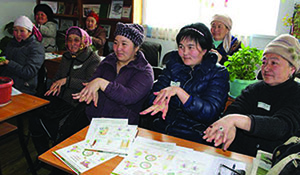
Box 6: Developing Guidelines for Iron Folic Acid (IFA ) Supplementation and Deworming in Kyrgyz Republic
SPRING supported development of national technical guidelines and clinical protocols.
IFA SUPPLEMENTATION: The Ministry of Health (MOH) decided to broaden the scope of anemia programming from treatment only to include a preventive regimen of IFA supplementation in pregnancy and the postpartum period to align with global recommendations. The MOH created a national-level anemia working group to draft a guideline that included both prevention and treatment centered on IFA supplementation. This policy change represents a significant government commitment to implement global recommendations to reduce anemia.
DEWORMING: Lacking national prevalence data, the MOH did not consider helminth infestations to be a public health priority, resulting in deworming campaigns that were sporadic and primarily donor-driven. The high prevalence of anemia motivated the MOH to reassess its main causes, leading to a review of the helminth infection situation. Prevalence data from small surveys and studies suggest a wide range of prevalence across the country. The MOH then reversed its earlier stance, formed a national-level working group on parasitic diseases, and drafted a new clinical protocol for both prevention and treatment of parasitic diseases.
Key Action 5: Plan and Implement at Subnational Levels
Many governments have shifted to a decentralized system, with decisions made at the subnational level. Using an established district committee to plan anemia efforts can facilitate its integration into the district planning cycle and sectoral work plans. Data related to anemia at the subnational level provides insights into gaps, enablers, and barriers, and can be used to prioritize action and mobilize stakeholders. SPRING’s District Assessment Tool for Anemia (DATA) (box 7) supports this process; local-level staff can customize the tool according to context (box 8).
Box 7: SPRING District Assessment Tool for Anemia (DATA)
DATA is an Excel-based tool with accompanying User and Facilitator’s Guides. The tool is completed during a two-day district-level workshop. DATA highlights contextual risk factors, identifies enablers and barriers to address risk factors, and assists district-level actors to prioritize actions/interventions.
DATA IS A THREE-PHASE PROCESS:
| Phase | Content |
|---|---|
| 1. Prepare for District Workshop | Complete national questionnaire with information regarding country’s national situation. Contact workshop participants to share objectives and expectations of the workshop. |
| 2. Conduct DATA Workshop | Introduce causes of anemia and need for a multi-sectoral approach. Fill out the district questionnaire using district data on anemia risk factors and program coverage. Use DATA’s dashboards to identify barriers and gaps. Prioritize activities and develop action plans. |
| 3. Implement and Follow Up | Return to respective sectors with the action plan to incorporate activities into a sectoral work plan. Monitor progress at the next district workshop. |
Box 8: Implementing DATA in Africa and South Asia
GHANA: DATA was piloted in Kumbungu district, followed by scale-up in seven districts in the Northern region by a team of master trainers including district managers in nutrition, education, disease control, agriculture, reproductive health, and environmental health. Future implementation is planned through two USAID implementing partners, Resiliency in Northern Ghana and Systems for Health. Despite scarcity of quantitative data at the district level, the tool facilitated a conversation around the quality of implementation efforts and motivated stakeholders to use information to improve implementation and advocate for further data collection. One participant stated, “Qualitative analysis is good, but we want figures. Figures help us plan.”
NEPAL: DATA was piloted in the Kapilvastu district and scale-up is planned through the USAID-funded project, Suaahara II. DATA was useful as a planning tool for anemia and an appropriate adjunct to the monitoring and evaluation framework of the Multi-sectoral Nutrition Plan. The Nutrition Food Security Coordination Committees will use DATA for joint planning and allotment of funds at the local level. They will also explore adaptation of the tool to address stunting. “DATA helps us know the situation of programs at community level, available resources, demand side factors, and gaps. From this, we know our situation and it makes it easy for future planning,” said one participant.
UGANDA: DATA was piloted in Namutumba, Arua, and Amuria districts and scaled-up in 15 districts in the Southwest through the USAID implementing partner Regional Health Integration to Enhance Services. The NAWG spearheaded the DATA pilot, using existing platforms of the District Nutrition Coordination Committees and the District Health Management Teams. The tool proved a useful resource in drafting district annual work plans. One participant observed, “The tool has a planning aspect which departments can use to identify actions to integrate into their work plans. When that is done, it is only a matter of time before we see changes that should help reduce anemia in the respective districts in Uganda.”
The experiences with DATA yielded several lessons:
- Involvement of national- and subnational- level stakeholders makes it possible to incorporate national-level policies and guidelines into district action.
- Multi-sectoral structures and systems at the district level can be used as a platform for DATA. Sector representation is required not only from health, agriculture, education, and WASH, but also local development, planning, and women’s empowerment entities.
- DATA provides an opportunity for integrated anemia implementation through common delivery platforms.
- The similarity of risk factors for stunting and anemia suggest the possibility of adapting DATA to guide interventions for both outcomes.
- The impact of DATA implementation, including sustained motivation and ownership, must still be measured.
- DATA should only be implemented after ensuring an adequate enabling environment and plan for supportive supervision.
We are successful because of community participation—when you involve the community in everything we do, we will be successful. The first thing the working group has to do is sensitization—not just radio, but face-toface with opinion leaders because they have a say.
-Sierra Leone NAWG member
We need to move from the conference rooms to the field where the people are, so we can have an impact.
-Uganda NAWG member
From Learning to Practice
- Build the capacity of an existing local platform, such as a health, nutrition, or development committee to coordinate anemia efforts and ensure sustainability.
- Engage community, opinion, religious, and local government leaders to act as “anemia champions.” The media can also play an important role in promoting anemia and have a wide reach.
- Use both quantitative and qualitative data to assess barriers and enablers, and prioritize actions.
- Advocate for increased collection and use of monitoring and evaluation data across departments and sectors to support evidence-based decisions.
- Strengthen communication and disseminate information between national and local levels, as weak links have hindered implementation in the past.
Key Action 6: Train Service Providers
Weak human resources and infrastructure capacities can constrain the implementation of anemia programs. Training service providers builds their knowledge and skills to deliver anemia prevention and control programs (box 9) and is an ongoing process. Training content may include the latest perspectives on anemia risk factors, existing reduction strategies and guidelines, delivery platforms for anemia control interventions, as well as quality assurance and quality improvement activities. Developing training curriculum that is not limited to the health sector, and is relevant for other sectors (e.g., education, agriculture) is encouraged. In addition, training is not limited to government staff but is also important for non-government staff and the private sector (e.g., media and food industry).
Training methods cannot be one-size-fits-all and should be socially and culturally compatible with the country context. Training is more effective when participants can incorporate and build on the knowledge and skills used in their daily work. Role-playing is an effective technique that can supplement didactic instruction.
From Learning to Practice
- Consider training for all relevant stakeholders, including the non-health sector and the private sector.
- Develop a training curriculum for both pre- and in-service training, clarifying the linkages between the risk factors for anemia and how different sectors can reduce anemia.
- Tailor the training curriculum to the country context, reflecting the latest country guidelines, service delivery platforms, and quality assurance and improvement processes.
- Use a peer-to-peer training methodology. Workers often learn better from peers within their professional environment, rather than with a top-down approach.
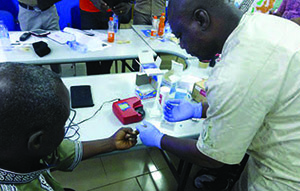
Box 9: Building Health Worker Capacity in Ghana, Kyrgyz Republic, and Uganda
SPRING supported the development of curricula and conducted training of trainer workshops
GHANA: The Ghana Health Service trained community and facility workers on anemia in the Northern region. A facilitator’s guide outlined training content and included an innovative approach to enable supervisory staff to follow up and support trainees. A user’s guide tailored anemia information to the literacy level (e.g., pictorial) of health workers and community volunteers. Using a peer-to-peer methodology, 720 workers were trained in districts where SPRING works. Continual training and supervision have enhanced health workers’ capacity to improve service delivery.
KYRGYZ REPUBLIC: The MOH provided training on new anemia guidelines and protocols (see box 5) as part of a women’s and infants’ nutrition curriculum. Significant emphasis was placed on building counseling skills and using hands-on learning techniques and field exercises to enhance participants’ confidence. Thirty-two master facilitator-trainers conducted a series of cascade trainings on anemia prevention and treatment for 1,465 health workers.
UGANDA: The Ministry of Education and Sports and the MOH collaborated to integrate anemia topics into the Bachelor of Medical Education curriculum at the Health Tutors College Mulago, the only institute for training tutors of midlevel health workers. The training package equips pre- and in-service teachers with the knowledge and skills to train health professionals in addressing anemia, and could be extended to social workers and school teachers, if found effective.
Conclusion
SPRING’s learning about anemia reduction from its work with countries highlights the importance of locally driven, context-specific approaches and illuminates ways that external actors can provide support.
Key actions to reduce anemia in a country include:
- Collect and use accurate and comprehensive anemia-related data at the national and district levels.
- Match interventions to the specific causes of anemia in a given context, and consider special target groups and costs.
- Establish coordination bodies to strengthen multi-sectoral stakeholder engagement and increase impact.
- Use guidance tools to facilitate action at national and district levels.
- Continually monitor and evaluate the process and make improvements accordingly.
CALL TO ACTION
- Join the Accelerated Reduction Effort on Anaemia (AREA) Community of Practice to share experiences and engage in the global anemia dialogue.
- Visit the U.S. Agency for International Development’s (USAID) Integrated Anemia Prevention and Control Toolkit on the Knowledge for Health website.
- Download “Understanding Anemia: Guidance for Conducting a Landscape Analysis” and “District Assessment Tool for Anemia (DATA)”
- Find out if a national anemia profile, which provides a snapshot of a country’s anemia situation, has been created for your country here. Use the profile to raise the visibility of anemia and encourage coordination of anemia efforts across sectors. The profile can also be used to monitor country progress on anemia-related targets and coverage of interventions.
- Learn about other multi-sectoral coordination efforts supported by USAID through SPRING here.
Footnotes
1 Source: Stevens et al. 2013
References
Balarajan, Yarlini, Usha Ramakrishnan, Emre Ozaltin, Anuraj H. Shankar, and S. V. Subramanian. 2011. “Anaemia in Low Income and Middle-Income Countries.” The Lancet 378 (9809): 2123–35.
Global Burden of Disease Pediatrics Collaboration. 2016. “Global and National Burden of Diseases and Injuries among Children and Adolescents between 1990 and 2013: Findings from the Global Burden of Disease 2013 Study.” JAMA Pediatrics 170(3): 267-87.
International Food Policy Research Institute (IFPRI). 2016. Global Nutrition Report 2016: From Promise to Impact: Ending Malnutrition by 2030. Washington, DC.
Lozoff, Betsy. 2007. “Iron Deficiency and Child Development.” Food and Nutrition Bulletin 28(4 Suppl): S560-71. Rahman, Md Mizanur, Sarah Krull Abe, Md Shafiur Rahman, Mikiko Kanda, Saki Narita, Ver Bilano, Erika Ota, Stuart Gilmour, and Kenji Shibuya. 2016. “Maternal Anemia and Risk of Adverse Birth and Health Outcomes in Low- and Middle-Income Countries: Systematic Review and Meta-Analysis.” American Journal of Clinical Nutrition 103(2): 495–504
Stevens, Gretchen A., Mariel M. Finucane, Luz Maria De-Regil, Christopher J. Paciorek, Seth R. Flaxman, Francesco Branca, Juan Pablo Peña-Rosas, Zulfiqar A. Bhutta, and Majid Ezzati. 2013. “Global, Regional, and National Trends in Haemoglobin Concentration and Prevalence of Total and Severe Anaemia in Children and Pregnant and Non-Pregnant Women for 1995–2011: A Systematic Analysis of Population-Representative Data.” Lancet Global Health 1(1): e16–25.
SPRING. 2016. Understanding Anemia: Guidance for Conducting a Landscape Analysis. (https://www.spring-nutrition.org/publications/ series/understanding-anemia)
SPRING. 2016. District Assessment Tool for Anemia (DATA). (https://www.spring-nutrition.org/publications/tools/ district-assessment-tool-anemia-data).
World Health Organization (WHO). 2015. The Global Prevalence of Anaemia in 2011. Geneva: World Health Organization. World Health Organization (WHO). 2014. World Health Assembly Nutrition Targets 2025: Anaemia Policy Brief. Geneva: World Health Organization.
U.S. Agency for International Development (USAID). 2014. Multi-Sectoral Nutrition Strategy 2014-2025. Washington, DC: USAID.

